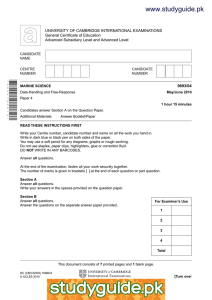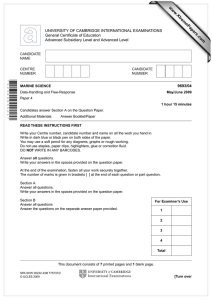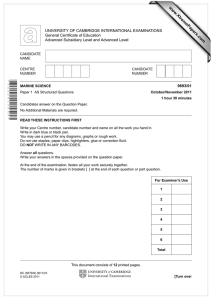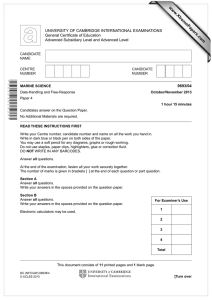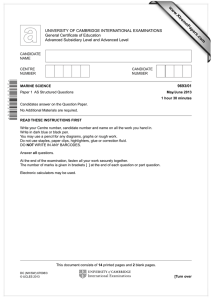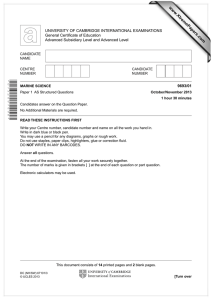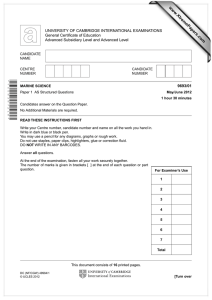www.XtremePapers.com
advertisement
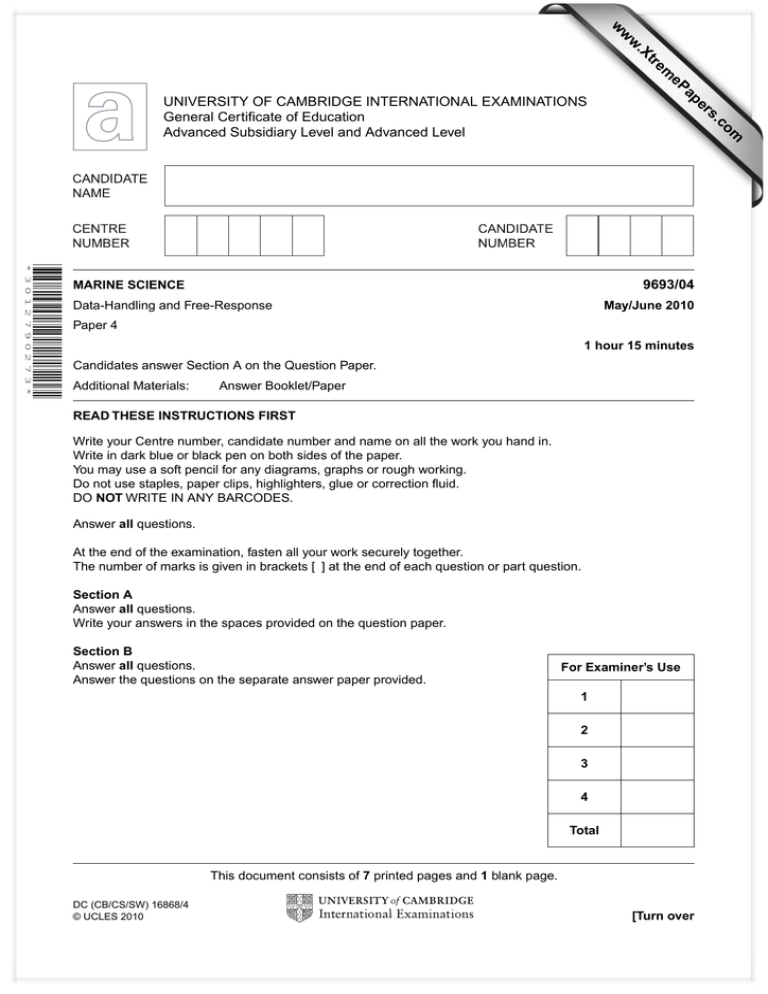
w w ap eP m e tr .X w om .c s er UNIVERSITY OF CAMBRIDGE INTERNATIONAL EXAMINATIONS General Certificate of Education Advanced Subsidiary Level and Advanced Level *3012790273* 9693/04 MARINE SCIENCE Data-Handling and Free-Response May/June 2010 Paper 4 1 hour 15 minutes Candidates answer Section A on the Question Paper. Additional Materials: Answer Booklet/Paper READ THESE INSTRUCTIONS FIRST Write your Centre number, candidate number and name on all the work you hand in. Write in dark blue or black pen on both sides of the paper. You may use a soft pencil for any diagrams, graphs or rough working. Do not use staples, paper clips, highlighters, glue or correction fluid. DO NOT WRITE IN ANY BARCODES. Answer all questions. At the end of the examination, fasten all your work securely together. The number of marks is given in brackets [ ] at the end of each question or part question. Section A Answer all questions. Write your answers in the spaces provided on the question paper. Section B Answer all questions. Answer the questions on the separate answer paper provided. For Examiner’s Use 1 2 3 4 Total This document consists of 7 printed pages and 1 blank page. DC (CB/CS/SW) 16868/4 © UCLES 2010 [Turn over 2 Section A For Examiner’s Use Answer both questions in this section 1 The amount of light, of a particular wavelength, that a pigment absorbs can be measured. It is possible to plot a graph to show how much light is absorbed at different wavelengths. This is called the absorption spectrum. Fig. 1.1 shows the absorption spectra of two pigments, chlorophyll a and fucoxanthin, found in marine algae. 100 90 80 Key: 70 chlorophyll a fucoxanthin 60 relative absorbance / % 50 40 30 20 10 0 300 350 400 450 500 550 wavelength / nm 600 650 700 Fig. 1.1 (a) (i) Describe the absorption spectrum for chlorophyll a shown in Fig 1.1. .................................................................................................................................. .................................................................................................................................. .................................................................................................................................. .............................................................................................................................. [2] (ii) Describe two differences between the absorption spectra of fucoxanthin and chlorophyll a. .................................................................................................................................. .................................................................................................................................. .................................................................................................................................. .................................................................................................................................. .............................................................................................................................. [2] © UCLES 2010 9693/04/M/J/10 3 maximum depth of light penetration / m (b) Fig. 1.2 shows the maximum depth that light of different wavelengths penetrates through sea water off the west coast of Chile. 300 0 350 400 wavelength / nm 450 500 550 600 650 For Examiner’s Use 700 10 20 30 40 50 60 70 80 Fig. 1.2 Suggest why green algae are found mainly near the surface of the water. .......................................................................................................................................... .......................................................................................................................................... .......................................................................................................................................... .......................................................................................................................................... ...................................................................................................................................... [2] © UCLES 2010 9693/04/M/J/10 [Turn over 4 (c) In a study, samples of water were collected at different depths. The concentrations of chlorophyll a and fucoxanthin in the sea water were determined at each depth. The results are shown in Fig. 1.3. 10 10 20 20 30 depth / m depth / m 0 concentration of chlorophyll a / mg m-3 0 2 4 6 8 10 12 0 concentration of fucoxanthin / mg m-3 6 8 0 2 4 30 40 40 50 50 60 60 Fig. 1.3 Use the information in Fig. 1.1 and Fig. 1.2 to suggest explanations for the results shown in Fig. 1.3. .......................................................................................................................................... .......................................................................................................................................... .......................................................................................................................................... .......................................................................................................................................... .......................................................................................................................................... .......................................................................................................................................... .......................................................................................................................................... .......................................................................................................................................... .......................................................................................................................................... ...................................................................................................................................... [3] [Total: 9] © UCLES 2010 9693/04/M/J/10 For Examiner’s Use 5 Fig. 2.1 shows the age of Georges Bank Atlantic cod commercial landings over the period of 1978–2004. The width of each circle represents the size of the catch at a particular age. year 2 For Examiner’s Use 1976 1978 1980 1982 1984 1986 1988 1990 1992 1994 1996 1998 2000 2002 2004 2006 1 2 3 4 5 6 age of fish / years 7 8 9 10+ Fig. 2.1 (a) Describe the general trends in catches between 1978–2004. .......................................................................................................................................... .......................................................................................................................................... ...................................................................................................................................... [2] (b) Using the data in Fig. 2.1 predict what will happen to cod stocks from 2004 and beyond. Explain your predictions. .......................................................................................................................................... .......................................................................................................................................... .......................................................................................................................................... ...................................................................................................................................... [3] © UCLES 2010 9693/04/M/J/10 [Turn over 6 (c) Table 2.1 shows the total international catches of North Sea cod for the period 1981–1991. Table 2.1 year Total cod catch / 1000 tonnes 1981 325 1982 300 1983 260 1984 225 1985 210 1986 200 1987 210 1988 195 1989 150 1990 130 1991 110 Calculate the percentage decrease of total cod catch for the entire 10 year period 1981–1991. Show all working. .......................................................................................................................................... .......................................................................................................................................... .......................................................................................................................................... ...................................................................................................................................... [2] (d) Suggest which fishing methods could be used to prevent the overfishing of the Georges Bank Atlantic cod, and how these methods could impact on the fishing towns of the area. .......................................................................................................................................... .......................................................................................................................................... .......................................................................................................................................... .......................................................................................................................................... .......................................................................................................................................... .......................................................................................................................................... .......................................................................................................................................... ...................................................................................................................................... [4] [Total: 11] © UCLES 2010 9693/04/M/J/10 For Examiner’s Use 7 Section B Answer all questions in this section. 3 (a) Describe the life cycle of the salmon stating the habitats for each stage. [7] (b) Discuss the advantages and disadvantages of internal and external fertilisation in marine organisms. [3] (c) Describe the care of the offspring of tuna and whale and in each case explain how maximal survival of the offspring is achieved. [5] 4 (a) State what is meant by intensive and extensive aquaculture. [2] (b) Name one marine species that is produced by aquaculture and describe the requirements for a successful and sustainable aquaculture venture. [6] (c) Suggest the likely impacts that aquaculture could have on local ecosystems and human populations. Discuss the steps that could be taken to minimise the impact. [7] [Total: 30] © UCLES 2010 9693/04/M/J/10 8 BLANK PAGE Copyright Acknowledgements: Question 2 Figure 2.1 © Graph of Georges Bank cod commercial landings by age between 1974-2004; http://www.nefsc.noaa.gov/sos/spsyn/pg/cod/ Permission to reproduce items where third-party owned material protected by copyright is included has been sought and cleared where possible. Every reasonable effort has been made by the publisher (UCLES) to trace copyright holders, but if any items requiring clearance have unwittingly been included, the publisher will be pleased to make amends at the earliest possible opportunity. University of Cambridge International Examinations is part of the Cambridge Assessment Group. Cambridge Assessment is the brand name of University of Cambridge Local Examinations Syndicate (UCLES), which is itself a department of the University of Cambridge. © UCLES 2010 9693/04/M/J/10



